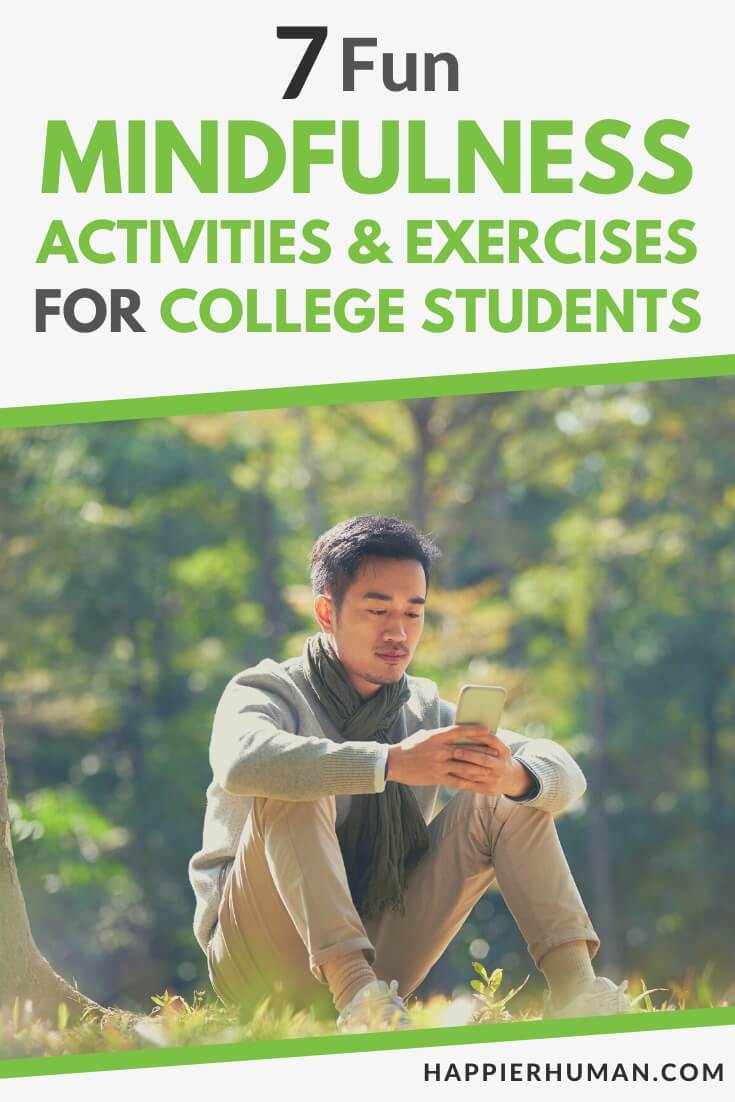A friend of mine has a niece in her first year of college. At first, everything was new and exciting, but as the months passed, she developed insomnia and complained of heart palpitations when it was close to exam time.
Are you a college student experiencing something similar, and you feel like you aren't handling some of the big feelings as well as you'd like to? Or do you have a child in college, and you'd like to give them some coping mechanisms to help them deal with the stressors of college life.
How about doing some fun mindfulness activities and exercises for college students? In this step-by-step guide, I'll show you how easy it is to incorporate mindfulness into college life. Let this guide help you deal with those uncomfortable and unwelcome feelings.
But before aligning our minds and bodies, let's examine why mindfulness is crucial for college students.
Why Is Mindfulness Important for College Student
College life is a whole new experience, and even though it's jam-packed with fun and parties, there are plenty of moments when life gets serious. There are classes to attend, exams and tests to write, social norms to develop, and friend circles to be made.
This can add serious stress and anxiety to even the most confident student's life. Adding mindfulness activities and exercises to your college life greatly benefits your mental and physical well-being.
Mindfulness will help you deal with situations better and teach you to find solutions rather than give up. It's a calm way to find your center when you feel like the world is collapsing around you.
These mindfulness activities for college students will help you develop healthy habits and show you that it's okay to slow down and take a breath now and then.
7 Mindfulness Activities for College Students
Here are 7 mindfulness activities for college students:
1. Mindfulness Journaling
One of the most powerful mindfulness activities for college students is mindful journaling. You might be thinking, “why would I want to write anything after sitting in lectures all day?” Well, hear me out.
Mindful journaling is a way to allow a stream of consciousness to flow from you directly onto the page, with no biased responses or judgments.
I have found that when I have a problem or an issue and I write about it in my journal, the answers often come to me by the third paragraph.

This is your journal and your thoughts. There is no wrong way when it comes to this activity. Write what you feel, even if your thoughts are all over the place. Put pen (or pencil) to paper.
How to do mindfulness journaling:
- Go out and buy yourself a journal. It can be lined, dotted, or plain. It's totally up to you.
- Set a time for journaling (I find the early mornings work best for me) and find a spot where you feel happy.
- Don't overthink it. Just start writing about anything, even if it's just about a piece of gum that attached itself to your shoe. You'll notice the words will start flowing in a direction.
- Carry your journal with you, and when you feel stressed, write about it, even if it's just three words.
2. Forest (or Tree) Bathing (Shinrin-Yoku)
As a college student, you’ll probably spend a lot of time indoors cooped up in your study or in libraries crunching notes (and surrounded by electronic devices).
This can lead to cabin fever, where you feel demotivated, isolated, and exhausted. The only way to solve this problem is by going outside and getting some fresh air. Shinrin-yoku (Japanese for bathing with the trees) will calm your senses and bring you back to your roots (literally).
When you feel sluggish and mentally drained, stop what you’re doing and head out to spend some time with the trees.
How to do forest bathing:
- You don’t need to walk through a forest if you don’t have one nearby. Simply find a spot with a tree or two and some soft grass (parks are great). Once you find a suitable place, you can sit or lie under the tree.
- Close your eyes, and breathe in deeply as you empty your mind of stressful thoughts. Feel the grass under your fingers as you release any tension on the exhale. Repeat this 3 to 5 times.
- When you’re ready, walk around and through the trees as you pay attention to the smell of the trees (and nature in general). Run your hands along the tree and feel the bark beneath your fingers. Listen to the sound of the wind rustling the leaves and watch how the light dances on your skin.
- Don’t rush. Sit in this moment as long as you like and appreciate the silence as you feel your mood lifting like the branches of a tree.
3. Wave Breathing
Overwhelm hits at the strangest times. It can creep up on you while you're in the middle of a lecture making notes or when you get to your dorm after a crazy busy day and you're having a quiet moment for the first time in a long while.
Feeling overwhelmed presents itself differently for everyone. You might find your heart rate increasing, your palms start sweating, or you feel like you can't breathe. Remember that this feeling will pass, and you will get through it.

Did you ever pick up a shell on the beach and put it to your ear as a kid? Can you remember that calming noise of the ocean that brought your world to a standstill? I want you to hold onto that feeling.
Now, take a deep breath.
How to do wave breathing:
- Exhale and close your eyes as you cup your hands over your ears (if you happen to have a seashell nearby, that's great).
- Take in a deep breath and hold it for 5 seconds. Blow out a long breath for 5 seconds and repeat three times.
- Gently breathe in through your nose and out through your mouth as you hear the air moving in and out beneath your cupped hands (or through the shell).
- Continue to breathe in and out and listen to how your breath sounds like waves lapping against the shore.
- Keep your hands cupped over your ears and continue breathing like this until you find your heart rate slowing and the world coming back into focus.
Mindful Suggestion: Keep a shell in your pencil bag or on your desk as an alternative so you can reach for it whenever you feel overwhelmed.
4. Squeeze and Release
Sitting at a desk for long hours studying can put a lot of strain on your eyes, body, and mind. You might not even realize that you're tensing up and trapping unwelcome feelings in your body (like stress or anxiousness).
In moments like these, you need to listen to your body, acknowledge the tension in your shoulders, and own the discomfort. Now it's time to realign your mind and body (as the one can't work efficiently without the other).
A great way to do this is by checking in with yourself and doing a “squeeze and release” mindful sequence.
Find a safe place to lie down, and get ready to let go.
How to squeeze and release:
- Let your arms and hands lie loosely at your sides while your feet flop outwards. Don't tense any part of your body, and let it all “hang loose” (imagine you have no bones).
- Close your eyes and breathe in and out slowly. Take a moment to acknowledge your feet by wiggling your toes. Squeeze them tight and release them, and then relax them. Feel the blood flow rush to your toes.
- Next, focus on your legs as you leave your feet in peace. Do your legs feel tense or tired? Acknowledge this feeling as you tighten the muscles in your legs. Release them.
- Now move to your hands as you wiggle your fingers and ball them into fists. Release all the tension from your knuckles as you let your hands relax again.
- Acknowledge your elbows and pull your shoulders towards your ears as you tense the muscles. Release them.
- Slowly roll your neck from side to side as you feel the tension disappearing. Keep breathing as you tuck your chin to your chest. Let your head roll to the side and be still.
- Relax fully and enjoy how your body feels at this moment. Listen to your heartbeat, and it's perfectly okay if you doze off for a few minutes.
- When you're ready, you can sit up and stretch your arms above your head and continue your day.
5. Make a Vision Board
Every college student should have a vision (or intentions) board up in their rooms. It gives you a visual reminder of your hopes and dreams and helps you plan mindfully. You don't need a massive board with flashing neon lights. It can be simple and bold.
It would be best if you looked at your vision board daily, and you'll find yourself focusing on the positive parts of your life. You'll also be inspired to reach those dreams. If you focus on something important, your visions will manifest themselves into reality in one way or another.
How to make a vision board:
- Choose the material on which you'd like to place your pictures (canvas works well) and gather some pictures from magazines. You can also paint pictures on the board if you want.
- You'll need materials such as glue, pens, paper, washi tape, and scissors.
- Take a moment to reflect on what you want out of life. Find images and words that inspire you to reach these goals and add them to your board. You can lay it out and assemble the images any way you like.
- When you're satisfied with the layout, go ahead and glue your images down. Add some glitter or washi tape to make it stand out more.
- Place your board in a place where you'll see it, and take a minute every morning to focus on your goals while you enjoy a cup of tea or coffee.
6. Affirmation Hugs
There isn't much that a hug can't fix. Affirmation hugs are a quick mindfulness activity you can do on the run, and it's a great way to slow down an uncomfortable moment.

As a college student, you might be away from your parents, and sometimes all you want is a hug and words of encouragement to show that everything will be okay.
How to do affirmation hugs:
- You can sit down or stand up for this activity. Close your eyes and breathe in deeply. Take note of the emotion you're feeling and exhale through your nose.
- Hug yourself by wrapping your arms tightly around yourself.
- Squeeze your arms reassuringly as you sway slightly from side to side and repeat some affirmations to yourself, such as “I've got this” or “I am doing the best I can, and that's enough.”
- Do this until the unwelcome feelings subside and you feel calmer.
7. Goodnight Mindful Meditation
While starting your day right is essential, ending your day correctly is just as important. What better way to do this than by preparing your mind and body for a good night's rest with a goodnight mindful meditation.
This is a great activity to use as a bedtime routine, and it will help you relax and drift into sleep naturally. Sleep is one of the most essential things in our lives (yet, we sacrifice it way too often), and a good night's rest will help you deal with the challenges of a new day.
Sleep debt, as a result of insomnia (or too few hours spent sleeping), is genuine and can lead to severe fatigue that will affect you mentally and physically.
So make sure you're catching enough Zs at night.
How to do a goodnight mindful meditation:
- Start by putting your phone or tablet away (preferably away from your bed), so you can't reach it.
- Get into some comfy PJs and open a window for fresh air.
- Turn down the lights and snuggle into bed with a warm cup of chamomile tea (avoid drinking coffee, as this will keep you awake).
- As you sip your tea, think about all the great things you accomplished today.
- Once your tea is finished, fluff up your pillow and lie down comfortably. Breathe in and out slowly as you notice any aches in your body. Notice your heartbeat and let your body fully relax.
- As you drift off to sleep, think of three things you're grateful for today. Listen to the quiet sounds of the night as you continue to breathe in and out.
Goodnight, sleep well.
Final Thoughts on Mindfulness Activities for College Students
College is an exciting time packed full of amazing opportunities (I mean, you are literally paving the way for your future). As a college student, you must find healthy ways to cope with every day stressors.
You are in a new phase of your life and may find it hard to be away from home. Stress from assignments, exams, and deadlines can also become a bit much. Doing mindfulness activities is a way of saying, “Okay, my feelings are all over the place, and I need a moment.”
Mindfulness doesn't have to be long-winded. You only need a few minutes to sit down with your feelings, acknowledge them, and shake them off. You'll feel so much better once you've dealt with your feelings calmly.
If you enjoyed this article and want to try out more mindfulness activities in your daily life, check out our guide to mindfulness activities for adults or mindful activities to try at work.
Finally, if you want a simple way to reduce your stress and anxiety, then try writing these 35 mindfulness journaling prompts to live more in the present moment.


